Lessons Learned from the Process of Water Injection Management in Impactful Onshore and Offshore Carbonate Reservoirs
Abstract
:1. Introduction
2. Overview of Carbonate Reservoirs
3. Summary of Waterflood Cycle
3.1. Importance of Integrated Waterflood Asset Management
- (1)
- Enhancing recovery from huge remaining OIP (oil in place) in carbonates, which requires effective reservoir management from “day 1”—billions of barrels of recoverable oil;
- (2)
- Designating the proper timing, which has a significant impact on recovery efficiency;
- (3)
- Maximizing volumetric sweep early on in the project’s life, as trying to squeeze more oil from marginal fields will yield marginal to average results;
- (4)
- Identifying the purpose (take the “bull by the horns” and solving the problem without any delay):
- Determining the key components of an effective IOR (improved oil recovery) asset management strategy;
- Describing important problems and technical areas;
- Considering all environmental issues;
- Gaining advantages from managing IOR as a team.
3.2. Technology Development Process
3.3. Factors Affecting Waterflood Recovery
- (1)
- Recovery efficiency, which is the result of volumetric sweep efficiency pore-to-pore displacement efficiency, is influenced by several factors:
- Reservoir heterogeneity, including natural fractures, directional permeability, crossflow, and non-communicating layers, which impacts volumetric sweep;
- Reservoir fluid properties, such as viscous fingering, mobility ratio, and residual water/oil/gas saturations, which affect microscopic displacement;
- High gas or water saturation, which may create channels that allow injected water to bypass oil;
- Unbalanced flood patterns due to variations in permeability, pattern type and size, and variable injectivity and productivity, which can reduce sweep efficiency;
- Lack of fluid communication between injectors and producers due to geological structure (crossbedding, discontinuity, faulting), which impairs sweep efficiency.
- (2)
- Carbonate reservoirs often exhibit significant heterogeneity, with considerable variation in both areal and vertical properties.
- (3)
- The flood patterns of producers and injectors, as well as their completions, complicate fluid movements close to the wellbore and inside the porous medium.
- (4)
- Reservoir rock wettability, where
- More favorable conditions are available for water-wet reservoirs compared to oil-wet reservoirs;
- Oil-wet reservoirs can be efficiently flooded as well in some circumstances;
- It is noteworthy that heavy oil reservoirs are able to be flooded efficiently.
- (5)
- Pre-existing fractures or fractures created by injecting above parting pressure can adversely impact sweep efficiency.
- (6)
- Higher reservoir pressure maintains lower oil viscosity and a higher oil formation volume factor, which is favorable, but requires more investment.
- (7)
- Maximum incremental oil recovery is achieved at or near the saturation pressure when the oil formation volume factor is highest.
3.4. Guidelines for Waterflooding
- (1)
- Rigorous reservoir characterization: detailed understanding of reservoir architecture, heterogeneities, permeability and porosity variations, oil saturation distribution, fractures/fracture networks, fluid communication pathways, reservoir continuity, and rock–fluid interactions/wettability;
- (2)
- Estimation of pay areas with the bulk of recoverable hydrocarbon: identify thin high-permeability layers/streaks, estimate portion of overall pay containing the bulk of mobile oil, and analyze primary depletion performance to infer high/low permeability areas;
- (3)
- Pattern configuration and performance analysis: evaluate different flood patterns (five-spot, line-drive, peripheral, etc.), conduct pattern balancing, assess the need for infill drilling, track flood fronts, and analyze profile data;
- (4)
- Data gathering, analysis, and analytics: a comprehensive data acquisition program (well logs, cores, production data, injection data, 4D seismic, tracer tests, etc.), and integrated database, and advanced analytics like numerical simulation;
- (5)
- Well testing and reservoir pressure monitoring: well tests (pressure transient, injection profiling), interference testing between injectors/producers, field-wide pressure monitoring, and pressure transient analysis;
- (6)
- Information management: databases for reservoir, wells, facilities, and water system parameters, workflow for updating models with new data, and data visualization tools;
- (7)
- Mineral reaction and wettability: assessing rock–brine interactions, the impact on wettability, the potential for scale/fine migration, and the remedial treatments required;
- (8)
- Environmental considerations: surface handling of produced water, optimal water quality for injection, treatment requirements, and disposal of waste streams;
- (9)
- Facility design and operations: design of surface facilities (water treatment, injection/production equipment), automation, well monitoring, and control systems;
- (10)
- Surveillance and management: integrated team-based surveillance, proactive monitoring and control actions, and modification of operations based on performance data
3.5. Why Do Some Waterfloods Fail?
- (1)
- Vertical permeability variations cause early breakthrough: water bypasses oil zones and reduces the efficiency of oil displacement. This occurs because water tends to flow through zones of higher permeability, leading to uneven displacement and early breakthrough in these high-permeability pathways.
- (2)
- Fractures and directional permeability: fractures can act as high-permeability channels that lead to rapid water movement, bypassing large volumes of oil and reducing sweep efficiency. Directional permeability, where permeability is higher in one direction, can cause anisotropic flow patterns, complicating the displacement process and leading to suboptimal recovery. One way to manage the situation is to align the injection wells along the direction of the fractures, thus taking advantage of the anisotropy in an effective manner.
- (3)
- Fluid distribution in a thick reservoir with high vertical permeability: the injected water may preferentially flow into higher-permeability zones or vertically segregate downward, leading to uneven displacement across the reservoir. This results in poor sweep efficiency and leaves significant portions of the reservoir unswept, thereby reducing overall recovery.
- (4)
- Viscous fingering and poor mobility ratio: viscous fingering occurs when there is a large difference in viscosity between the injected water and the oil. A poor mobility ratio, where the water is much less viscous than the oil, exacerbates this problem. This leads to unstable displacement fronts and the formation of fingers or channels of water that bypass oil, significantly reducing the efficiency of the waterflood.
- (5)
- Unbalanced injectivity: unbalanced injectivity refers to the variations in the ability of different injection wells to take in water. This can be caused by differences in reservoir properties, well conditions, or operational issues. Such imbalance leads to an uneven distribution of injected water, causing some areas to flood more quickly than others, and thus, the inefficient displacement of oil.
4. Design of Waterfloods: Geological, Engineering, and Operational Considerations
- (1)
- Phase 1: conceptual planning and opportunity identification
- Assess reservoir characteristics, including depth, thickness, temperature, and properties of the oil such as gravity and viscosity;
- Outline potential injection patterns and explore alternatives;
- Estimate initial rates and pressures for both injection and production phases;
- Determine water source, quality, and compatibility with the reservoir;
- Establish the projected lifespan of the waterflood project;
- Gather and review all available data on the project, reservoirs, wells, and facilities, noting any missing information;
- Provide rough cost estimates for the pump system, water sourcing and treatment, facility modifications, well drilling and completion, equipment changes, and operational expenses;
- Conduct a preliminary economic screening to assess the project’s feasibility based on reasonable estimates.
- (2)
- Phase 2: development and evaluation of alternatives
- Collect, validate, consolidate, manage, and store data for reservoir study and asset development planning;
- Form a multidisciplinary team to conduct a detailed study and explore various development alternatives, producing:
- A comprehensive reservoir description;
- Analysis of drilling and production performance;
- Predictions of waterflood performance using reservoir simulations or traditional methods;
- Comparative analysis of similar fields, if data are available;
- An integrated plan for the waterflood system;
- Economic analysis and risk assessment, identifying key economic drivers and risks;
- Initiation of unitization proceedings with other partners if necessary;
- Designing pilot research or injectivity test if required.
- (3)
- Phase 3: detailed evaluation of preferred alternatives
- Conduct a thorough analysis of the best possibilities for waterflood (e.g., five-spot, nine-spot, line drive, peripheral flood). This evaluation should utilize core and log data, completion data, production performance analysis (including oil, water, and GOR (gas-oil ratio)), pressure performance analysis, reservoir rock and fluid analysis, operating costs, and laboratory or pilot test results.
- Select the best alternative(s) for detailed design and development, creating comprehensive waterflood design plans, and estimating development costs.
- Perform detailed risk and environmental assessments.
- Negotiate unitization parameters if needed.
- Conduct economic and risk analyses, and determine the expected value of the project.
- Seek approval from management and regulatory authorities.
- Develop and document a waterflood asset management plan, including key performance metrics.
- (4)
- Phase 4: implementation of waterflood and management plan
- a.
- Complete equipment and material selection, sizing, and thorough design.
- b.
- Carry out the asset management strategy, which includes the following:
- Drilling and/or recompleting wells;
- Erecting the required infrastructure;
- Installing field and artificial lift apparatus.
- c.
- Complete the waterflood operating plan and schedule.
- d.
- Develop a surveillance and monitoring plan for the waterflood.
- e.
- Assemble and train the operating team.
- (5)
- Phase 5: operation, monitoring, and evaluation
- Continuously monitor the performance of the reservoir, wells, and facilities;
- Evaluate performance against established metrics;
- Update the dynamic reservoir model with new data from ongoing operations and evaluations;
- Adjust plans and strategies based on actual performance;
- Identify opportunities for project expansion;
- Develop a strategy for the eventual termination of the waterflood.
5. Onshore Case Studies
5.1. Means San Andres Unit (MSAU)—Case 1
5.1.1. Reservoir Description
5.1.2. Field History
- (1)
- Monitoring of injection (water) and production (oil, gas, and water);
- (2)
- Control of injection pressures through step rate tests;
- (3)
- Pattern balancing using computer balance programs;
- (4)
- Injection profile control to ensure injection into all pay zones;
- (5)
- Specific production profiles;
- (6)
- Fluid level checks to ensure pump-off of producing wells.
- (1)
- All floodable pay zones had producers and injectors completed;
- (2)
- Reservoir pressure was maintained close to the MMP of 2000 psi;
- (3)
- Injection pressure was maximized and maintained at less than the fracturing pressure;
- (4)
- Producers were discharged.
- (5)
- Injection fluids were ensured to be well distributed vertically.
- (6)
- A pattern of balanced injection and withdrawals was preserved.
5.1.3. Summary
5.2. Denver Unit—Wasson San Andres Field—Case 2
5.2.1. Reservoir Description
5.2.2. Field History
- (1)
- Open-Hole vs. Cased-Hole Completions
- (2)
- Fiberglass vs. Steel Liner Installations in Injectors
- (3)
- Injection Profile Control
- (4)
- Computer Production Control
- (5)
- Well Completion and Well Stimulation
- (6)
- Artificial Lift.
- (7)
- Remedial and Reconditioning (R&R) Activity.
5.2.3. Summary
5.3. Offshore Case Study
5.3.1. Pre-Salt Introduction
5.3.2. Lula Field
5.3.3. Reservoir Description
5.3.4. Field History
- (1)
- Perform sufficient data acquisition during exploratory and early development phases;
- (2)
- Implement pilot projects to collect important dynamic information and anticipate profits with previously obtained data;
- (3)
- Deploy definitive production systems based on robust drainage strategies and build under different reservoir scenarios;
- (4)
- Conduct production management through the application of innovative technologies in ultra-deep offshore environments, e.g., WAG and 4D seismic monitoring, and use intelligent completions.
- (1)
- Digital monitoring and data integration:The extensive use of permanent downhole monitoring, well tests, tracers, etc., of all producers and injectors helps track the performance and characterize reservoir dynamics and heterogeneities.
- (2)
- Water and gas production controlled via WAG injection:Instead of venting CO2 into formation, which would come with unwanted fluids, WAG injection proves to be effective in preventing early breakthrough, and 5.4 million tons of CO2 were reinjected until May 2017.
- (3)
- Intelligent completion applications:
- Using inflow control values to choke off high water/gas zones and maximize production.
- Thirty-nine wells equipped with intelligent completion until April 2017.
- (4)
- Production management:Optimizing the distribution of produced/injected fluids across wells/areas to balance depletion.
- (5)
- Convertible wells to accelerate production growth:Some wells are designed to be convertible before drilling (almost no extra expenses to do that) to aid pressure maintenance with updated data analysis.
- (6)
- Dynamical appraisal from extended well tests (EWTs) without gas flaring:The data obtained from EWT brought dynamic information on non-drained areas of the reservoir, where a new development project would be deployed later. Producing new wells on existing FPSOs to acquire data without flaring associated gas becomes possible.
- (7)
- Water injection design:The position of injector wells is affected by the main field heterogeneities. It mitigates risks of short-circuiting the injected fluid towards the producing wells and improves sweep efficiency if designed properly. By proper design, we mean we should try our best to place the injection wells in alignment with higher directional permeability. Otherwise, the water breakthrough could be severe.
- (8)
- Optimization of well stimulation:All pre-salt wells are acid-stimulated right after completion due to the carbonate reservoir heterogeneity. Using two-stage acid treatments and diverters greatly helps improve coverage.
- (9)
- Use of 4D seismicity:Four-dimensional seismicity provides powerful support in characterizing reservoirs after a few years of production and water/gas injection. It helps monitor reservoir drainage and identify remaining oil zones.
5.3.5. Summary
6. Key Lessons Learned Summary
- (1)
- Rigorous reservoir characterization is crucial, including understanding reservoir architecture, heterogeneities, fracture networks, fluid communication pathways, and rock–fluid interactions.
- (2)
- Integrated multidisciplinary teams involving geologists, reservoir engineers, production engineers, and field operators are essential for successful waterflood design, implementation, and optimization. Our industry often makes mistakes when this integrated approach is not followed in a rigorous manner.
- (3)
- Pattern configuration, well placement, and injection/production strategies should be tailored to the specific reservoir characteristics and continually optimized based on surveillance data. These strategies are not to be performed only once while preparing the initial FDP (field development plan), but to be followed as an “evergreen” process.
- (4)
- Comprehensive data acquisition, advanced analytics, numerical simulations, and frequent model updates are necessary for effective reservoir management and decision-making. In today’s world, the use of data analytics, machine learning, and AI (artificial intelligence) is invaluable.
- (5)
- Proactive monitoring, surveillance, and control actions are vital for addressing issues such as water channeling, early breakthrough, and sweep inefficiencies. There was a time when most of the efforts focused on reservoir performance. Today, we realize it is equally important to include wells, facilities, operating conditions, water quality, and environmental and regulatory conditions.
- (6)
- Innovative technologies like intelligent completions and 4D seismic monitoring can significantly improve waterflood performance in complex carbonate reservoirs. Other technologies, like LSWF (low-salinity waterflooding), infill drilling with and without horizontal wells, zonal injection improvement, injection pattern modification, injection below formation parting pressure, pressure maintenance, workovers for injection and production wells, continuous data collection, gas cap barrier water injection, heavy oil waterflooding, slim-tube dual completions, and satellite waterflooding for pilot and marginal field waterflooding, should also be considered, as they can have significant impact.
7. Conclusions
- (1)
- Integrated waterflood asset management, incorporating geological, engineering, and operational aspects, is necessary for maximizing economic value and optimizing oil recovery from carbonate reservoir;
- (2)
- The design, implementation, and surveillance of waterfloods in carbonate reservoirs should be approached from a holistic perspective, considering the unique challenges posed by the complex pore systems, fracture networks, and heterogeneities present in these reservoirs;
- (3)
- Case studies from the Permian Basin and pre-salt Lula Field demonstrate the importance of detailed reservoir characterization, multidisciplinary team collaboration, advanced monitoring techniques, and continuous optimization to achieve successful waterflood performance in carbonate reservoirs;
- (4)
- The lessons learned from these case studies provide valuable insights into identifying and mitigating factors that can lead to waterflood failures, enabling more effective waterflood management strategies for future projects in carbonate reservoirs.
Author Contributions
Funding
Data Availability Statement
Conflicts of Interest
Appendix A. Agbami Oilfield
Appendix A.1. Reservoir Description
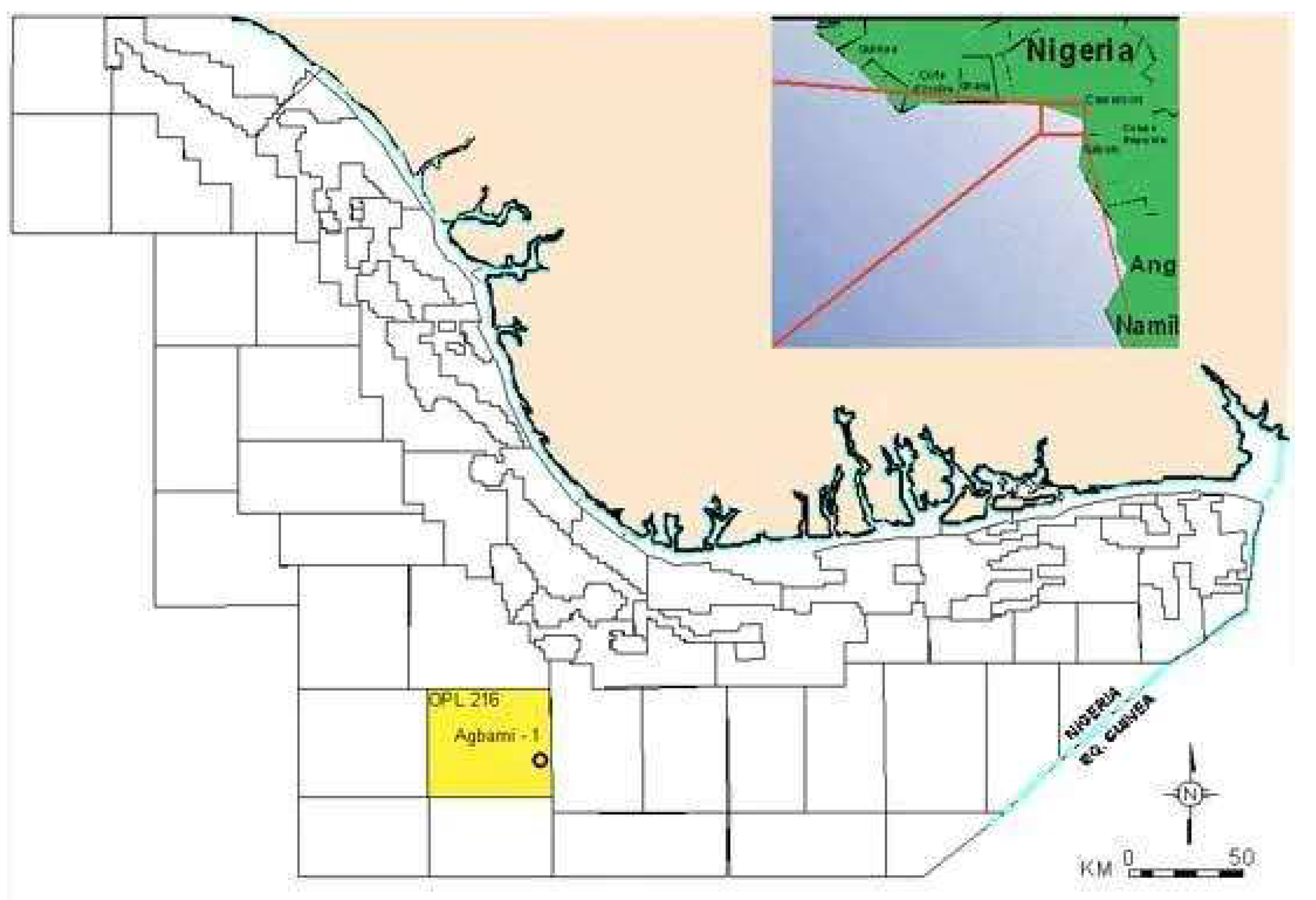
| Main formation | Lower and middle Miocene deep-water turbiditic sandstones |
| Estimated area, acre | 45,000 |
| Type of crude | Light |
| Depth, ft | 4800 |
| Average porosity, % | 18 |
| Permeability, md | 150 to 2000 |
| Initial pressure, psi | 7000 |
| Bubble point pressure, psi | 3000 |
| Stock-tank oil gravity, API | 45 to 49 |
| GOR, scf/stb | 1000 |
| Estimated OOIP, billion bbls | 2.8 |


- (1)
- The highly channelized deep-water environment results in a range of static and dynamic subsurface uncertainties within the field. Understanding the communication across the main thrust fault is challenging.
- (2)
- Optimized injection volumes of gas and water should be ensured to manage the flood fronts and reservoir pressures, within the constraints of well availability, well deliverability, and other operational limitations.
- (3)
- The complex subsea development architecture of the field means long lead times and high costs for implementing solutions to issues that arise during production.
- (4)
- Uncertainty in reservoir depletion across the field post-production, which impacts the ongoing development of the drilling program, must be dealt with.
- (5)
- The various operational challenges faced on a daily basis, such as well interactions, sand production, slugging, etc., should be managed while maintaining optimal production.
Appendix A.2. Field History

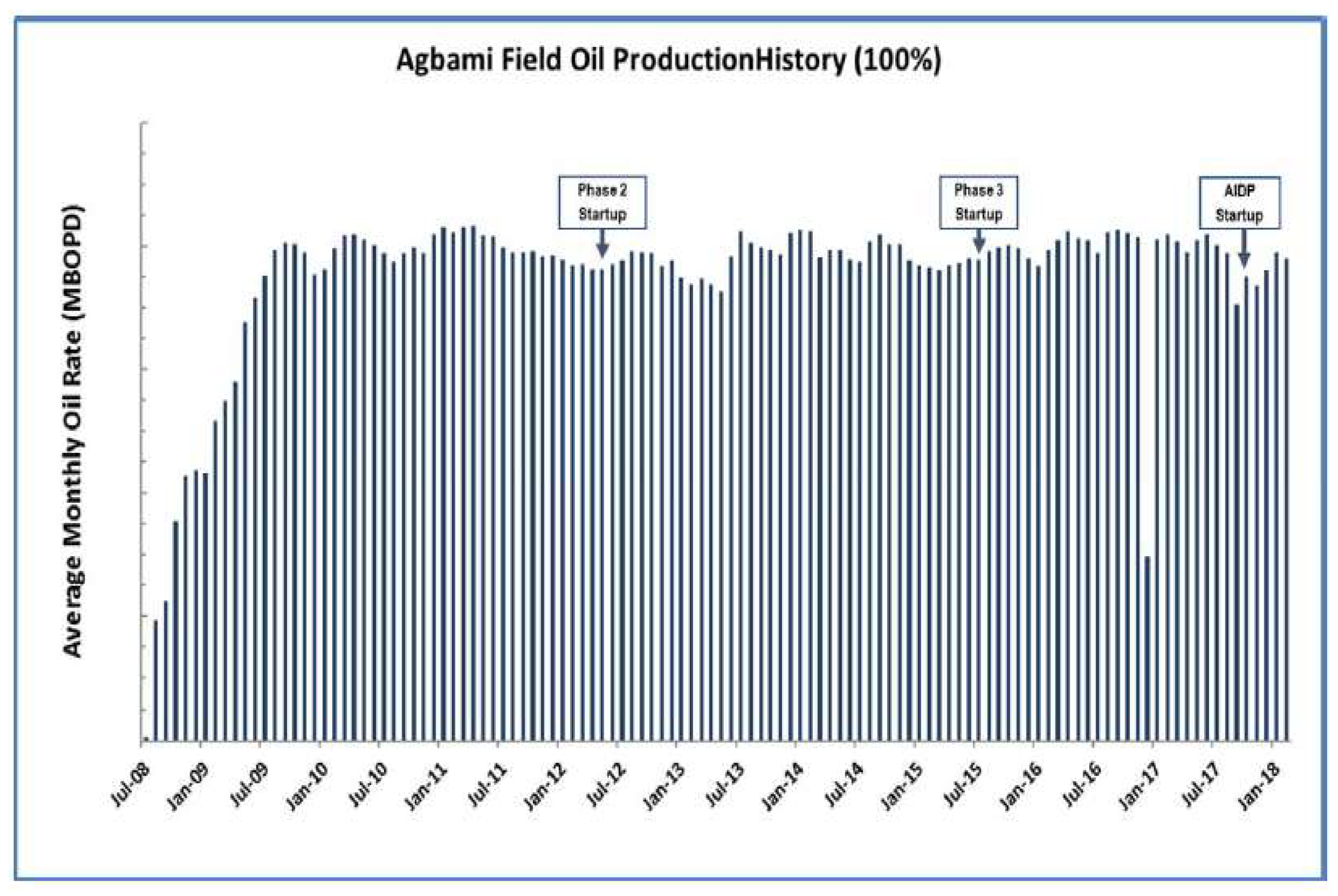
- (1)
- The phased field development approach: the field was developed in multiple phases (phases 1–4), allowing learnings and data from each phase to optimize well locations and production strategies for subsequent phases;
- (2)
- Robust reservoir management practices: a strong focus on reservoir characterization, integration of all available data sources like well logs, cores, seismic monitoring, production, 4D seismic monitoring, etc., and reduction of uncertainties over time.
- (3)
- Simultaneous water and gas injection strategy: mid-flank oil production with downdip water injection and crestal gas injection enhanced sweep efficiency and pressure support;
- (4)
- Advanced technology deployment: intelligent well completions for real-time monitoring and control of zones were used;
- (5)
- Strong project execution: Chevron’s structured project development and execution processes (CPDEP, WC-CPDEP) were adopted;
- (6)
- People competency: staff comprised experienced professionals with complementary skillsets from different regions.
Appendix A.3. Summary
References
- U.S. Energy Information Administration. U.S. Energy Facts Explained. Available online: https://www.eia.gov/energyexplained/us-energy-facts/ (accessed on 24 April 2024).
- Satter, A.; Thakur, G.C. Integrated Petroleum Reservoir Management: A Team Approach; PennWell Corp.: Tulsa, OK, USA, 1994. [Google Scholar]
- Thakur, G.C. The Role of Reservoir Management in Carbonate Waterfloods. In Proceedings of the SPE India Oil and Gas Conference and Exhibition, New Delhi, India, 17 February 1998. [Google Scholar]
- Thakur, G.C. Waterflood Surveillance Techniques—A Reservoir Management Approach. J. Pet. Technol. 1991, 43, 1180–1188. [Google Scholar] [CrossRef]
- Xu, Z.-X.; Li, S.-Y.; Li, B.-F.; Chen, D.-Q.; Liu, Z.-Y.; Li, Z.-M. A Review of Development Methods and EOR Technologies for Carbonate Reservoirs. Pet. Sci. 2020, 17, 990–1013. [Google Scholar] [CrossRef]
- Nairn, A.; Alsharhan, A. Sedimentary Basins and Petroleum Geology of the Middle East; Elsevier: Amsterdam, The Netherlands, 1997. [Google Scholar]
- Wilson, J. A Review of Carbonate Reservoirs. In Facts and Principles of World Petroleum Occurrence—Memoir 6; CSPG Special Publications; AAPG Datapages, Inc.: Tulsa, OK, USA, 1980; pp. 95–117. [Google Scholar]
- Hong, J.; Wang, Z.; Li, J.; Xu, Y.; Xin, H. Effect of Interface Structure and Behavior on the Fluid Flow Characteristics and Phase Interaction in the Petroleum Industry: State of the Art Review and Outlook. Energy Fuels 2023, 37, 9914–9937. [Google Scholar] [CrossRef]
- Stiles, L.H.; Magruder, J.B. Reservoir Management in the Means San Andres Unit. J. Pet. Technol. 1992, 44, 469–475. [Google Scholar] [CrossRef]
- Encyclopaedia Britannica. Permian Basin. Available online: https://www.britannica.com/place/Permian-Basin (accessed on 8 August 2024).
- Magruder, J.B.; Stiles, L.H.; Yelverton, T.D. Review of the Means San Andres Unit CO2 Tertiary Project. J. Pet. Technol. 1990, 42, 638–644. [Google Scholar] [CrossRef]
- Mineralanswers Production Profile of Means San Andres Unit. Available online: https://www.mineralanswers.com/texas/andrews-county/properties/means-san-andres-unit/08-17503 (accessed on 8 August 2024).
- Garcia Quijada, M. Optimization of a CO2 Flood Design Wesson Field—West Texas. Master’s Thesis, Texas A&M University, College Station, TX, USA, 2005. [Google Scholar]
- Ghauri, W.K. Production Technology Experience in a Large Carbonate Waterflood, Denver Unit, Wasson San Andres Field. J. Pet. Technol. 1980, 32, 1493–1502. [Google Scholar] [CrossRef]
- Mathis, R.L. Reservoir Geology of the Denver Unit—Wasson San Andres Field, Gaines and Yoakum Counties, Texas. Permian Basin SEPM Publ. 1986, 86, 43–47. [Google Scholar]
- Fleming, E.A.; Brown, L.M.; Cook, R.L. Overview of Production Engineering Aspects of Operating the Denver Unit CO2 Flood. In Proceedings of the SPE/DOE Enhanced Oil Recovery Symposium, Tulsa, OK, USA, 4 April 1992. [Google Scholar]
- Occidental Oil Company. Oxy Denver Unit CO2 Subpart RR Monitoring, Reporting and Verification (MRV) Plan; Occidental Oil Company: Huston, TX, USA, 2015. [Google Scholar]
- Thai, B.N.; Hsu, C.F.; Bergersen, B.M.; Albrecht, S.L.; Richardson, T.W. Denver Unit Infill Drilling and Pattern Reconfiguration Program. In Proceedings of the SPE Permian Basin Oil and Gas Recovery Conference, Midland, TX, USA, 21 March 2000. [Google Scholar]
- Pre-Salt from Petrobras. Available online: https://www.petrobras.com.br/pre-sal (accessed on 8 August 2024).
- da Costa Fraga, C.T.; Capeleiro Pinto, A.C.; Branco, C.C.M.; de Sant´Anna Pizarro, J.O.; da Silva Paulo, C.A. Brazilian Pre-Salt: An Impressive Journey from Plans and Challenges to Concrete Results. In Proceedings of the Offshore Technology Conference, Houston, TX, USA, 4 May 2015. [Google Scholar]
- de Moraes Cruz, R.O.; Rosa, M.B.; Branco, C.C.M.; de Sant’Anna Pizarro, J.O.; de Souza Silva, C.T. Lula NE Pilot Project—An Ultra-Deep Success in the Brazilian Pre-Salt. In Proceedings of the Offshore Technology Conference, Houston, TX, USA, 2 May 2016. [Google Scholar]
- Hauville, B.; Rueda Terrazas, R.; Henrique, S. CO2 from Southeast Asia to Brazil: Making Your Enemy Your Ally? In Proceedings of the Offshore Technology Conference-Asia, Kuala Lumpur, Malaysia, 25 March 2014.
- Formigli, J.M.; Capeleiro Pinto, A.C.; Almeida, A.S. SS: Santos Basin’s Pre-Salt Reservoirs Development: The Way Ahead. In Proceedings of the Offshore Technology Conference, Houston, TX, USA, 4 May 2009. [Google Scholar]
- Rosa, M.B.; de Araújo Cavalcante, J.S.; Miyakawa, T.M.; de Freitas, L.C.S. The Giant Lula Field: World’s Largest Oil Production in Ultra-Deep Water Under a Fast-Track Development. In Proceedings of the Offshore Technology Conference, Houston, TX, USA, 30 April 2018. [Google Scholar]
- de Sant´Anna Pizarro, J.O.; Branco, C.C. Challenges in Implementing an EOR Project in the Pre-Salt Province in Deep Offshore Brasil. In Proceedings of the SPE EOR Conference at Oil and Gas West Asia, Muscat, Oman, 16 April 2012. [Google Scholar]
- Michelett, G.; Roberts, A.; Kalyondo, J.; Habashi, A.; Alhafidh, H.; Hascakir, B. Onshore and Offshore EOR Applications in Brazil: A Review Study. In Proceedings of the SPE Annual Technical Conference and Exhibition, Houston, TX, USA, 26 September 2022. [Google Scholar]
- de S. Pizarro, J.O.; Poli, R.E.B.; Rosa, M.B.; da Silva, V.C.; Branco, C.C.M.; Cunha, B.M.; Doria, M.A.F.S.; Alles, N.; Batello, D.; Pinto, A.C.C. Optimizing Production of Santos Basin Pre-Salt Fields through Sound Reservoir Management Practices. In Proceedings of the OTC Brasil, Rio de Janeiro, Brazil, 24 October 2017. [Google Scholar]
- Odusote, F. Deepwater Nigeria Field Development: Challenges, Best Practices and Lessons Learned from the Agbami Field. In Proceedings of the SPE Nigeria Annual International Conference and Exhibition, Lagos, Nigeria, 5 August 2013. [Google Scholar]
- Offshore Technology. Agbami Oilfed. Available online: https://www.offshore-technology.com/projects/agbami/ (accessed on 6 August 2024).
- Jeboda, O.; Bodunrin, A.; Atuanya, C.; Ogidi, E. Reservoir Management Best Practices and Lessons Learned from the Agbami Field. In Proceedings of the SPE Nigeria Annual International Conference and Exhibition, Lagos, Nigeria, 6 August 2018. [Google Scholar]
- Hollister, H.D.; Spokes, J.J. The Agbami Project: A World Class Deepwater Development. In Proceedings of the Offshore Technology Conference, Houston, TexasTX, USA, 3 May 2004. [Google Scholar]


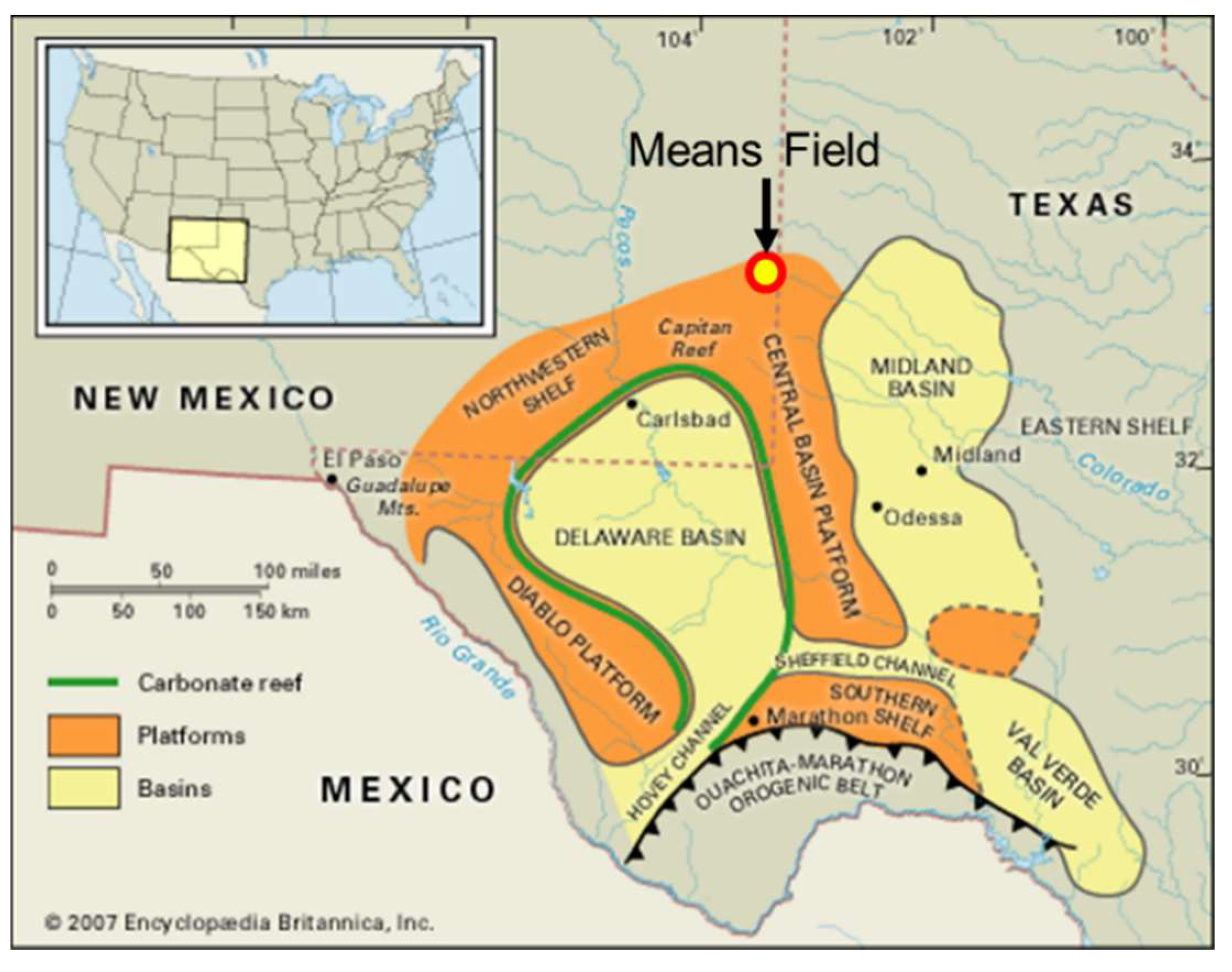



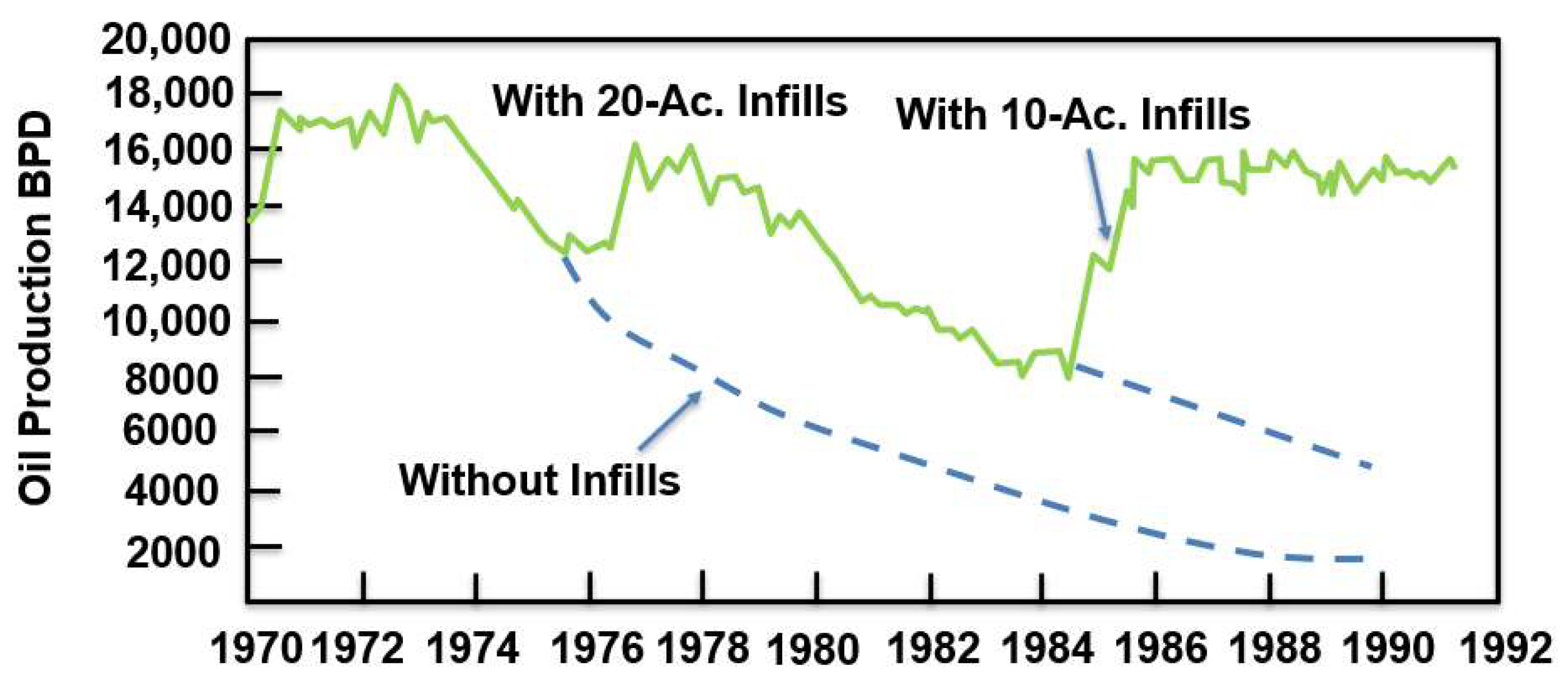




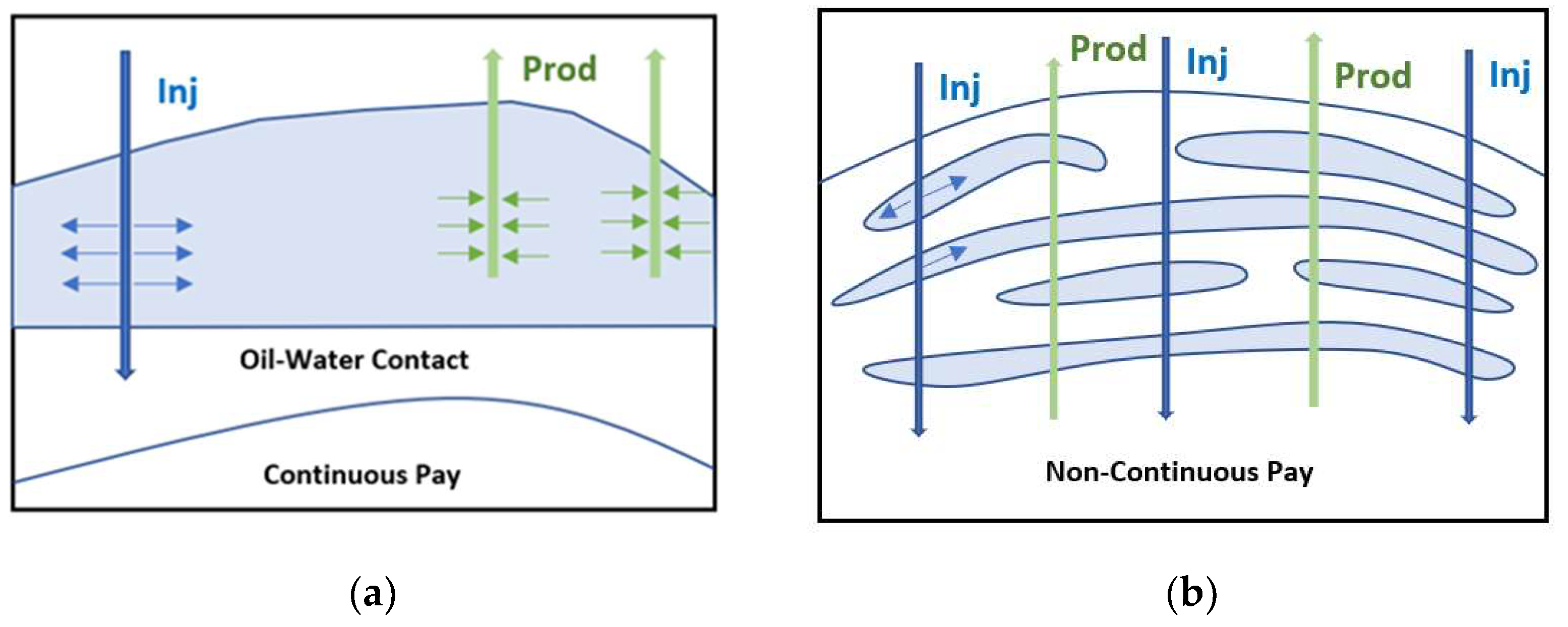

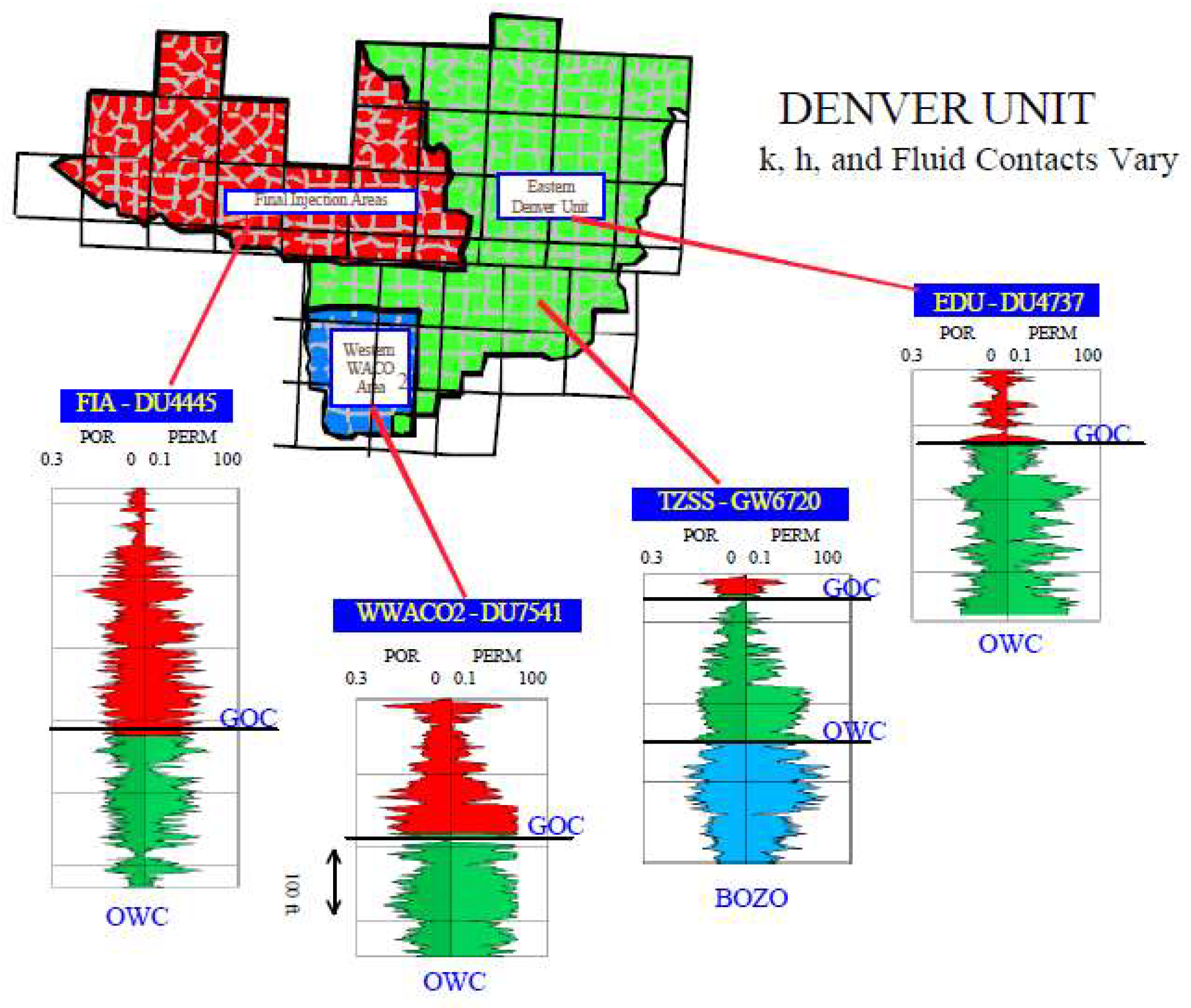

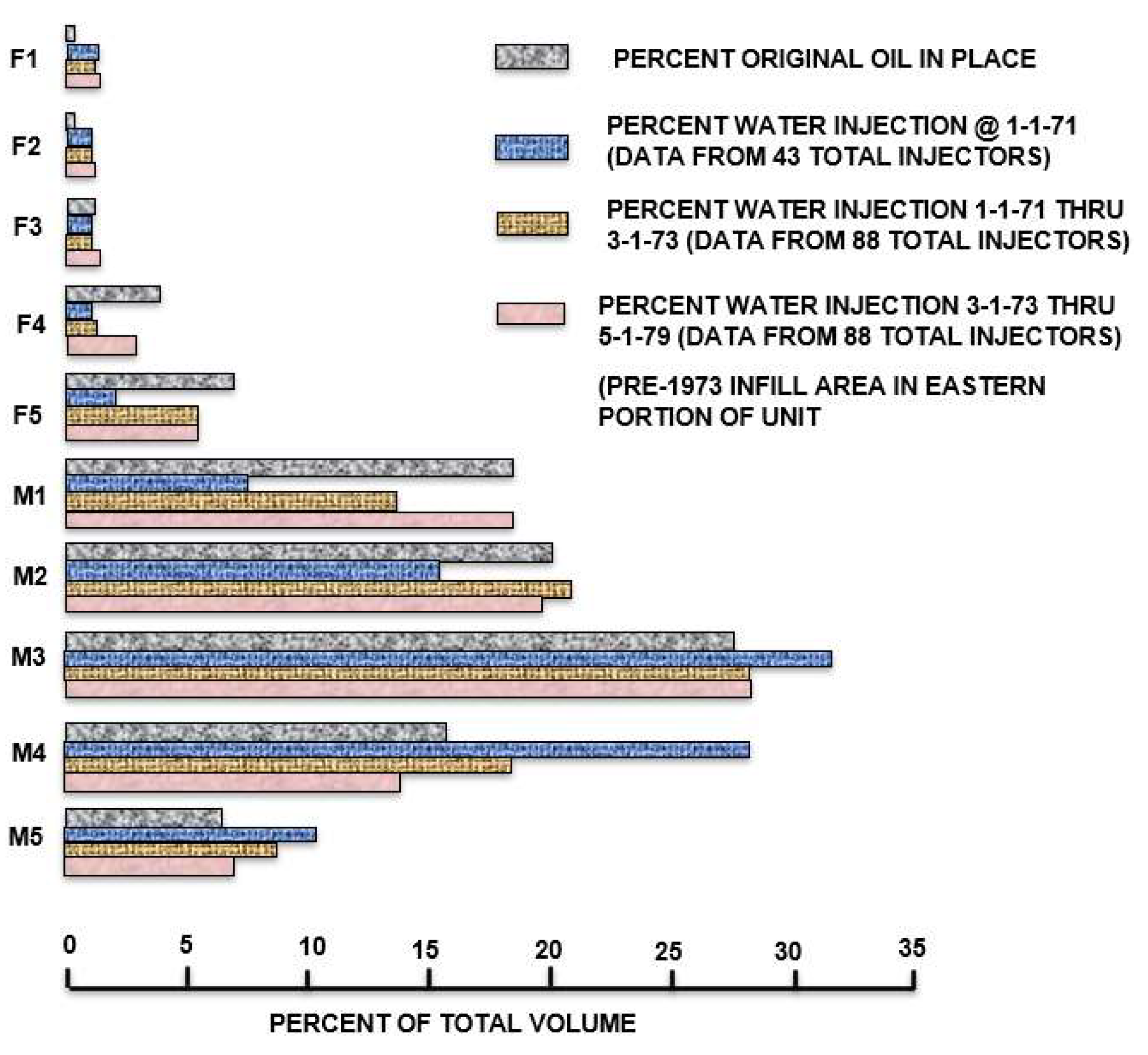
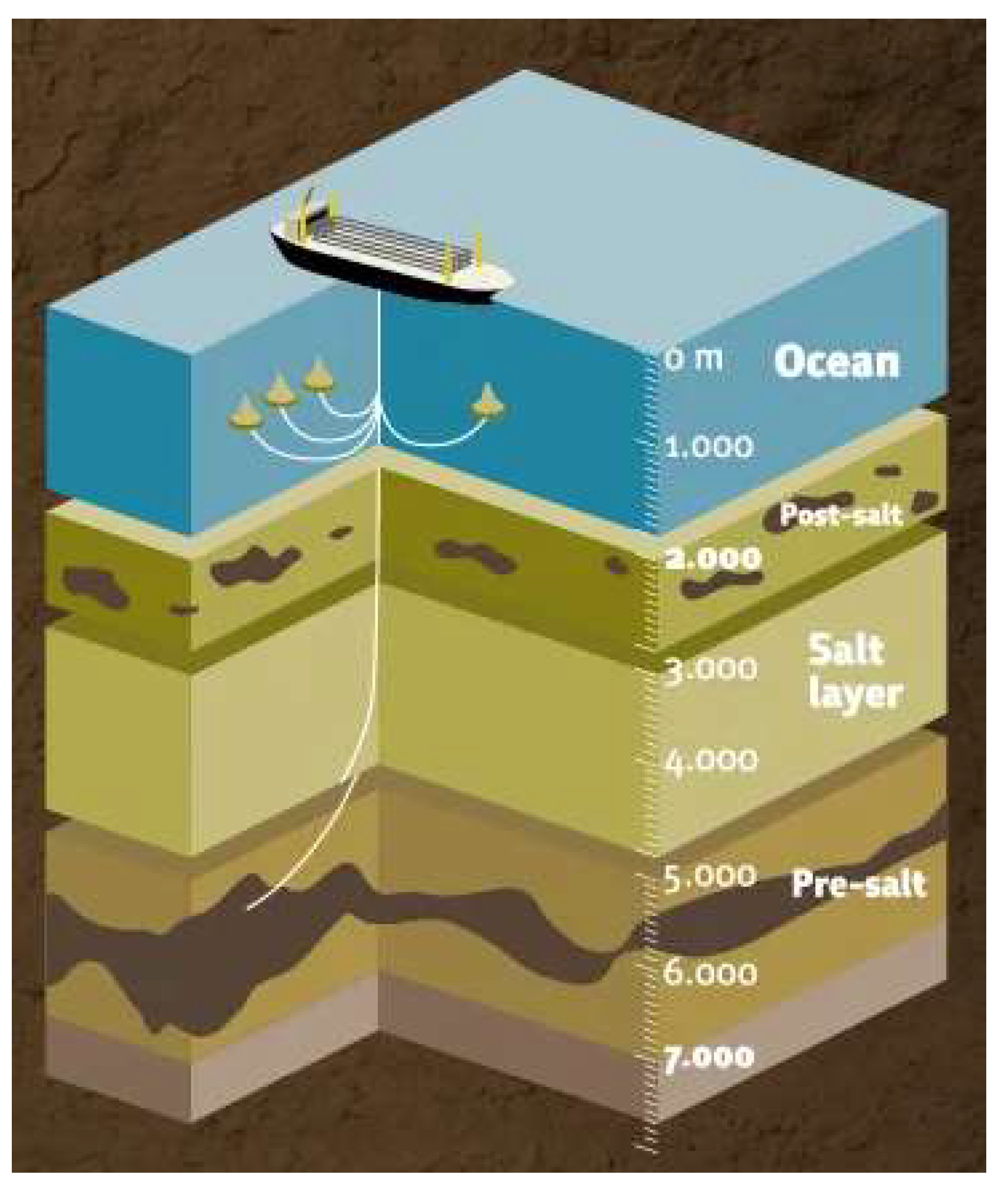
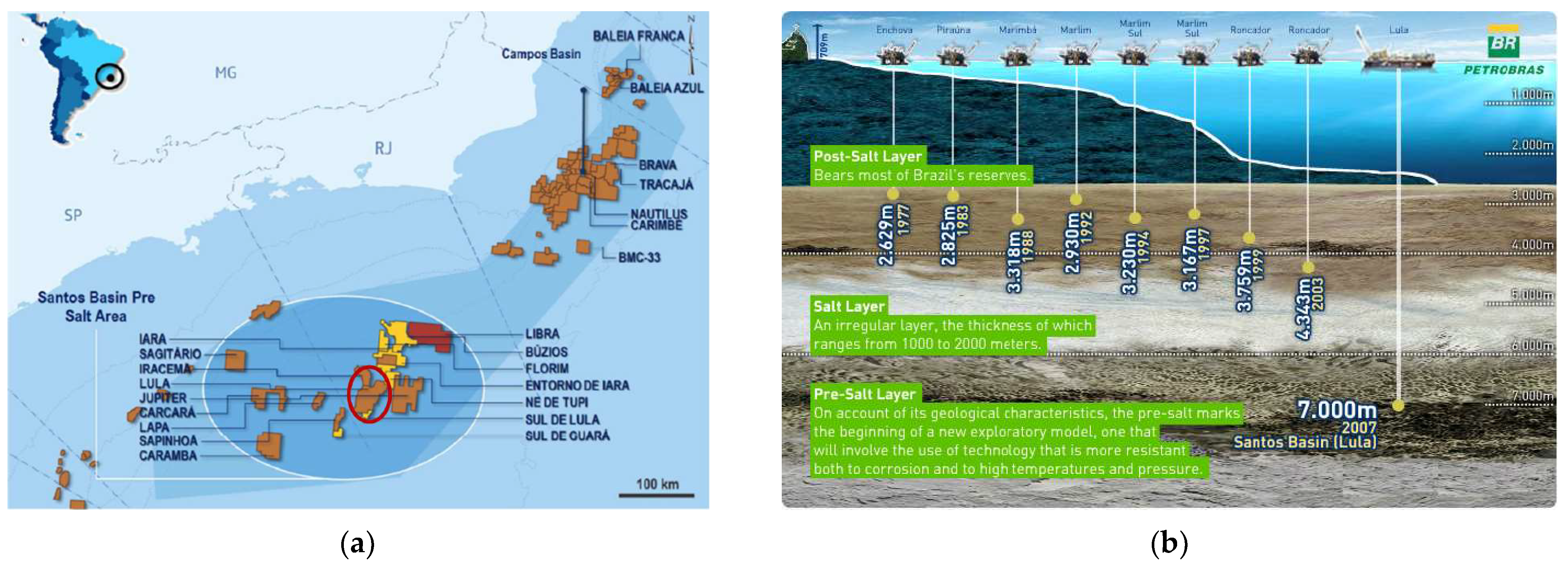
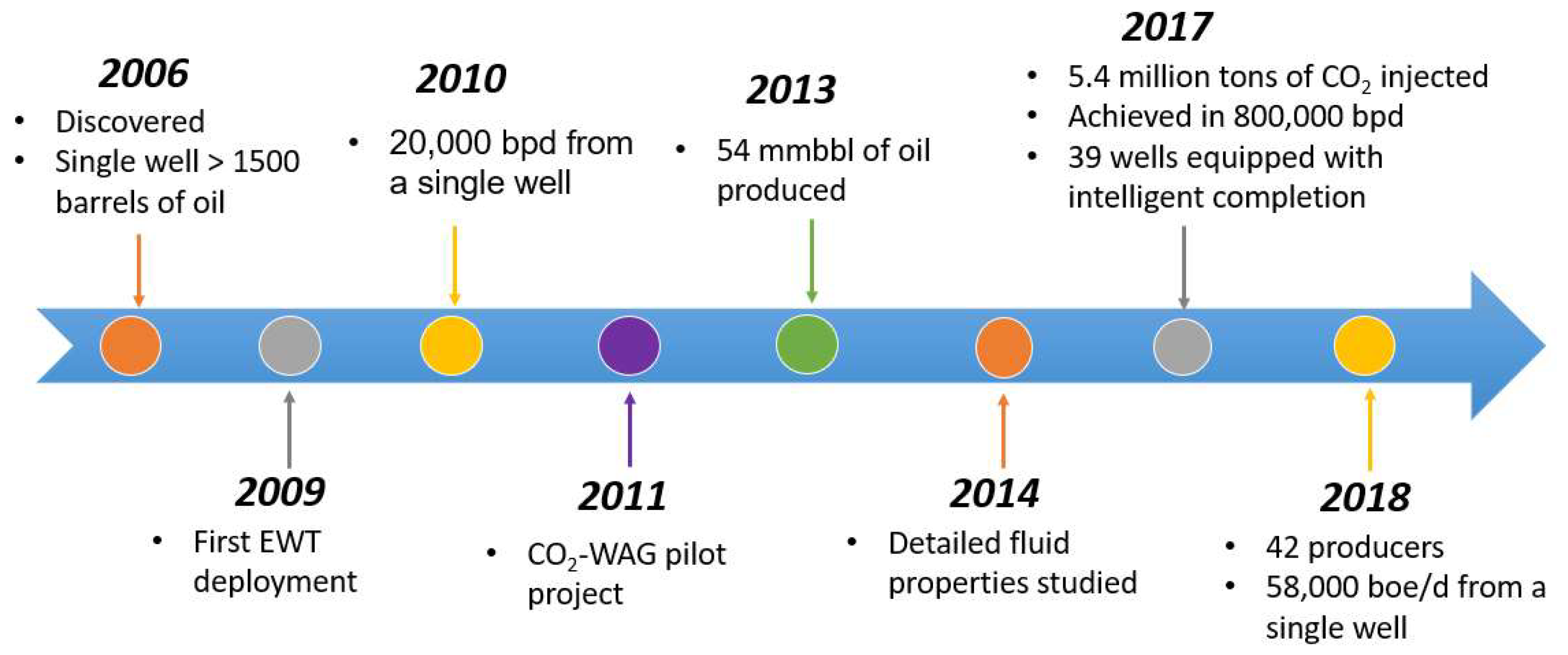
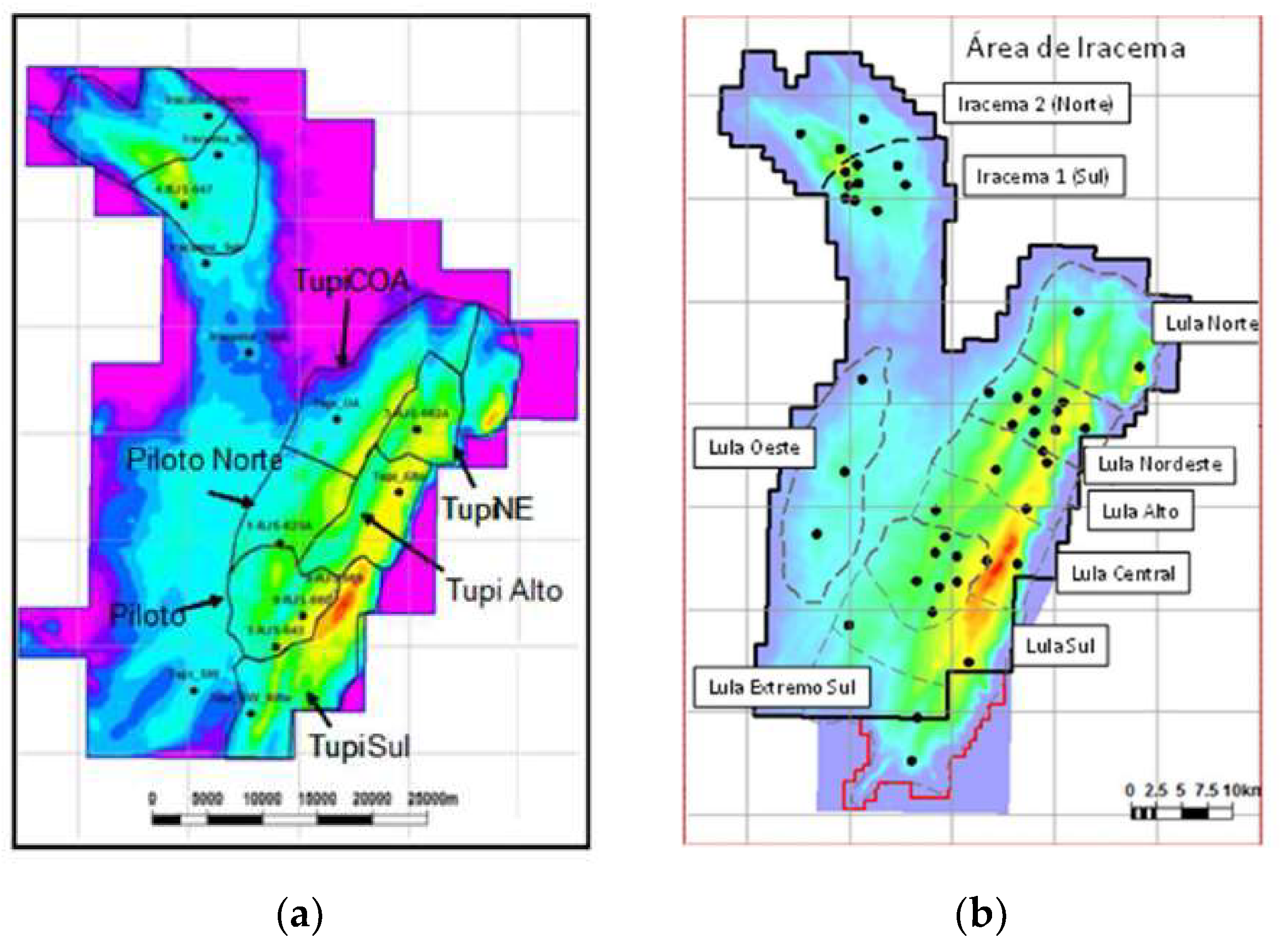



| Formation | San Andres |
| Lithology | Dolomite |
| Area, acres | 14,328 |
| Depth, ft | 4400 |
| Gross thickness, ft | 300 |
| Average net pay, ft | 54 |
| Average porosity, % | 9.0 (up to 25) |
| Average permeability, md | 20.0 (up to 1000) |
| Average Swi, % | 29 |
| Primary drive | Weak water drive |
| Average original pressure, psi | 1850 |
| Minimum miscible pressure (MMP), psi | 1850 to 2300 |
| Stock-tank oil gravity, API | 29 |
| Oil viscosity, cP | 6 |
| FVF, RB/STB | 1.04 |
| Saturation pressure, psi | 310 |
| Formation | San Andres |
| Lithology | Dolomite |
| Area, acres | 27,848 |
| Depth, ft | 4800–5200 |
| GOC, ft | 1325 |
| Gross thickness, ft | 200–500 |
| Average net oil pay, ft | 137 |
| Average porosity, % | 12 |
| Average permeability, md | 5 |
| Average Swc, % | 12 |
| Primary drive | Solution gas drive |
| Average original pressure, psig | 1805 |
| Reservoir temperature, °F | 105 |
| Stock-tank oil gravity, API | 33 |
| Oil viscosity, cP | 1.18 |
| Bo, RB/STB | 1.312 |
| GOR at original pressure, ft3/bbl | 420 |
| Saturation pressure, psi | 1805 |
| Minimum miscible pressure, psi | 1300 |
| OOIP (bbl) | 2.108 × 109 |
| Main formation | Barra Velha |
| Rock type | Carbonate |
| Area, km2 | 1600 (or 390,000 acres) |
| Type of crude | Light |
| Dead oil viscosity, cP | 1 |
| Depth, m | 5000–6500 (or 16,404 to 21,325 ft) |
| Porosity, % | 12 (can exceed 25) |
| Permeability, md | 50–1000 |
| Initial pressure, kgf/cm2 | 560 (or 7965 psi) at 4895 m TVDSS |
| Stock-tank oil gravity, API | 26–29 |
| Avg CO2 (vol%) | 8–18 |
| GOR, m3/m3 | 160–300 |
| Estimated OOIP, m3 | 4.8 × 109 (or 8.3 billion boe) |
Disclaimer/Publisher’s Note: The statements, opinions and data contained in all publications are solely those of the individual author(s) and contributor(s) and not of MDPI and/or the editor(s). MDPI and/or the editor(s) disclaim responsibility for any injury to people or property resulting from any ideas, methods, instructions or products referred to in the content. |
© 2024 by the authors. Licensee MDPI, Basel, Switzerland. This article is an open access article distributed under the terms and conditions of the Creative Commons Attribution (CC BY) license (https://creativecommons.org/licenses/by/4.0/).
Share and Cite
Du, X.; Thakur, G.C. Lessons Learned from the Process of Water Injection Management in Impactful Onshore and Offshore Carbonate Reservoirs. Energies 2024, 17, 3951. https://doi.org/10.3390/en17163951
Du X, Thakur GC. Lessons Learned from the Process of Water Injection Management in Impactful Onshore and Offshore Carbonate Reservoirs. Energies. 2024; 17(16):3951. https://doi.org/10.3390/en17163951
Chicago/Turabian StyleDu, Xuejia, and Ganesh C. Thakur. 2024. "Lessons Learned from the Process of Water Injection Management in Impactful Onshore and Offshore Carbonate Reservoirs" Energies 17, no. 16: 3951. https://doi.org/10.3390/en17163951
APA StyleDu, X., & Thakur, G. C. (2024). Lessons Learned from the Process of Water Injection Management in Impactful Onshore and Offshore Carbonate Reservoirs. Energies, 17(16), 3951. https://doi.org/10.3390/en17163951










